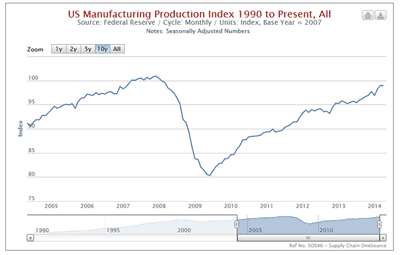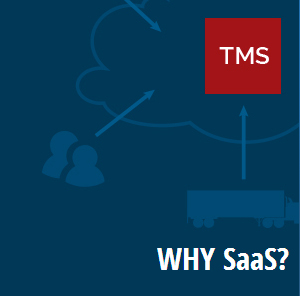 |
July 10, 2014 - Supply Chain Flagship Newsletter |
 |
Second MIT-SCDigest Study on US Manufacturing 2014 Is the Reshoring Trend Real? How has Thinking Changed Since 2012? |
|
|
If you PARTICIPATED and COMPLETED the 2012 Re-shoring Survey: |
 |
|
|
|
 |
|
||||||||||||||||||||||||||||||||||||||||||||||||||||||||||||||||||||||||||||||||||
1H 2014 Supply Chain Review
|
|||||||||||||||||||||||||||||||||||||||||||||||||||||||||||||||||||||||||||||||||||
| GILMORE SAYS: |
" What did I miss? Let me know. When it comes to supply chain, there's always something happening." WHAT DO YOU SAY? |
So, here we go, starting with some main themes.
As has been the case since 2014, the economy remained largely in lukewarm mode, though some may say I am being generous, as the latest revision to US real GDP showed a drop of a stunning 2.9% in the first quarter, from what started out as a .1% rise on the first estimate.
The terrible weather in parts of the country got some of the blame, but certainly not all of it. I don't believe it has felt like the economy is swooning, but rather that it keeps going at a modest growth pace. The Q2 numbers are likely to be better, but still it will be very hard now to get above 2% growth for the full year, after 2013's mediocre 1.9% gain. Is there really a big deal between 2% and 3% growth? Yes there is, as a famous economist once noted, and the difference is 50%.
Europe and China weren't much changed either, with little growth in Europe, which is worried about deflation, and slowing growth in China, though at rates well above most others.
In May, the number of US jobs finally climbed back to pre-recession levels, some seven years later, gaining back the 8.7 million jobs at last that had gone away in 2008-09. Not since the Great Depression had it taken that long to recover the jobs lost in a downturn.
Manufacturing remained a relative bright spot. The Purchasing Managers Index from the Institute for Supply Management has shown manufacturing growth for 13 consecutive months, starting January at a level of 51.3, just above the 50 mark that separates expansion from contraction, and ending the first half with a fairly strong reading of 55.3, down just a little from the 1H peak of 54.9 in April.
And as with job growth, US manufacturing output is at last on the cusp of returning to 2007 peak year levels. As shown in the chart below, US manufacturing output came in at an index level of 99.5 in May, meaning production volumes were just .5% below that 2007 average, and are likely to rise above 100 when the June numbers come out next week. That said, the recovery varies widely by sector, with many still far below 2007 levels.
US oil prices began the year at $95.67 and basically trended up from there, hitting a high of $105.94 on June 24 and then falling a couple of bucks by month's end. The global price for Brent crude basically matched the same pattern, but at a premium of $6-10 per barrel, as has been the case for many years now.
US diesel prices were pretty flat however, ranging between about $3.90 to $4.00 for the entire first half.
Geopolitical tensions in the South China Sea, Ukraine and more recently Iraq were certainly part of the overall supply chain landscape, though as yet none of these has broken out as a major crisis.
Omni-channel commerce and efulfillment continued to be the hottest topics and investment areas in the supply chain, with news and developments coming at a staggering pace, it often seemed.
US freight rates have been heading up rapidly in the 1H, with the Cass Linehaul Index up 5.7-6.0% in March through May, awaiting June numbers. Watch this one.
With that overview of the 1H, let's look at some of the top stories/events by month in 2014:
January
News that Amazon has received a patent for something called "speculative shipping,” which greatly simplified means Amazon would send packages to a market based on forecasts, not actual orders, then deliver to customers rapidly as real orders are received.
Chinese auto glass maker Fuyao Glass announces it will buy about 1 million square feet of the 2.5 million total at a shuttered GM plant near Dayton, OH made famous in after a 2008 HBO documentary on its closing called "The Last Truck: The Closing of a GM Plant." The company will invest some $200 million, and employ 800.
February
In a major defeat for the United Auto Workers and labor forces generally, workers at a VW plant in Chattanooga vote against unionization, despite management's quasi-support for organizing them. UAW at first says it will challenge the vote with the NLRB, but then drops that plan.
Also in the month, however, the NLRB says it will again propose so called "microwave” elections for unionization, which many believe will favor labor. Seems likely to become the law sometime in 2014.
News that Rolls Royce has been working with European officials on "drone” container and cargo ships that would have no crew, and be controlled by joy sticks and other technology from shore. It hopes to develop a prototype ship that can be sailed by the end of 2015.
March
News that Walmart execs still pushing store managers and others to do a better job keeping shelves stocked, saying at a company meeting that there is $3 billion in increases sales to be gained in US.
Amazon announced new "Dash” wand-like device that enables customers to order groceries in the markets serviced by its Amazon Fresh service via scanning product bar codes or simply speaking into the device (e.g, "skim milk”).
April
Walmart introduces new "WAVE” truck concept, which features very aerodynamic cab in which driver sits in the middle, and trailer made solely from low-weight carbon fiber. Just in R&D mode for now.
Reports that Amazon is testing its own fleet of delivery trucks for general merchandise deliveries in three US markets, and that it has plans to use its own trucks eventually in the top 40 US markets.
Supply chain professional organizations APICS and the Supply Chain Council (SCORE model) announce they are merging.
Zebra Technologies surprisingly announces it will be acquiring the radio frequency systems, bar code scanning and related products businesses from Motorola Solutions, which will focus just on its radio business.
May
JDA Software CEO Hamish Brewer loses job after many years at the helm, as private equity investors believe company not moving fast enough on new strategies.
Amazon CEO Jeff Bezos clarified long mysterious plans for the Kiva robotic picking system the company had acquired in 2012, saying Amazon would ramp the number of the robots in its DCs from about 1000 to some 10,000 by year's end.
Gartner releases annual top 25 supply chain list, with the top four (Apple, McDonald's, Amazon.com and Unilever) remaining unchanged from 2013, with P&G grabbing the fifth spot. It's far from perfect, but it's the best we've got.
June
The annual State of Logistics from CSCMP finds logistics costs in 2013 fell to 8.2% of GDP in 2013 from 8.3% in 2012, largely on falling freight rates and lower interest rates for inventory. But as noted above that trend is unlikely to hold for 2014.
UPS joins FedEx in planning for dimension weighting programs for US ground shipments, likely to raise parcel shipping costs for most.
China regulators kill plan for P3 container shipping alliance between Maersk Line, Mediterranean Shipping Co., and CMA CGM, after consortium had received Ok from US and Europe. Move would have changed the dynamics of container industry. Maersk and MSC just announced plans for two-carrier alliance, however.
Contract with the Longshoremen at West Coast ports expires on June 30, but the docks keep working during negotiations, as positioning thus far has been relatively cordial. Competitive pressure may lead to modest gains for workers, but "Cadillac" healthcare plan fines under Obamacare for terminal operators could be big issue.
What did I miss? Let me know. When it comes to supply chain, there's always something happening.
What major trends or events in 1H 2014 did we miss? Let us know your thoughts at the Feedback section below.
![]()
| View Web/Printable Version of this Column |
|
|
|
YOUR FEEDBACK
Just catching up on some feedback from the past few weeks, including a good analysis of Amazon's reported plans to build its own parcel delivery fleet from Subhash Chowdary of Aankhen.
Feedback on the Amazon's Parcel Fleet Plans:
The "last mile" may not be the accurate term in these new models where the first and last mile is the same; ie. from a local service point in less than a few hours after order placement. This also stretches the concept of a "like" already on its way and delivered at the door step to a user already receiving a delivery. For example lets take grocery deliveries. How many times do we do grocery shopping with lists only to come home and get reminded of the things we missed or should have been on the list? Amazon already knows my 'likes' from the various sources it has. I place an order and then when the delivery is taking place, Some of the items I usually buy are offered as an option. I would like that! There is also another effect of this exercise. The service providers will give Amazon a break on the already discounted cost to retain the business and raise the price on everyone else. The consumer will pay one way or another unless there is a lower total cost alternative. The increase in Prime has already happened once. It is in our own interest that they look at alternatives. Subhash Chowdary |
||
| More on Amazon Plans: | ||
It sure sounds good and certainly "doable" for the likes of Amazon. They just need all those drivers like the rest of us in supply chain transportation. Eugene V. Nusekabel |
||
On a GDP and the Supply Chain: |
||
It is important to understand both the fluffed up components and the reality of GDP, just as it is important to understand the holes in conventional thinking about unemployment numbers. Before we get tangled up in GDP, it might be better to start with understanding the basics of enterprise income statements and balance sheets, and get comfortable with notions such as cash flow, ROA, ROE, ROI, assets, liabilities, and the like. Art van Bodegraven |
||
Thanks to SCDigest for the explanation of GDP calculation and how it connects with the supply chain. You are exactly right - nearly all of us hear and throw out these numbers without really having any understanding of what they mean. I frankly did not connect how much a company's supply chain decisions in the end add up to really impact GDP growth. Thank you.
Alex Wagner Riverside, CA |
||
SUPPLY CHAIN TRIVIA ANSWER
Q: What is the West Coast port's share of US container traffic?
A: 43.5% in 2013 - but that's down from 48% in 2007, as ports in Mexico and Canada have gained share, with more pressure sure to come from an expanded Panama Canal in 2015.
| © SupplyChainDigest™ 2003-2014. All Rights Reserved. SupplyChainDigest PO Box 714 Springboro, Ohio 45066 |
POWERED BY: XDIMENSION
|









